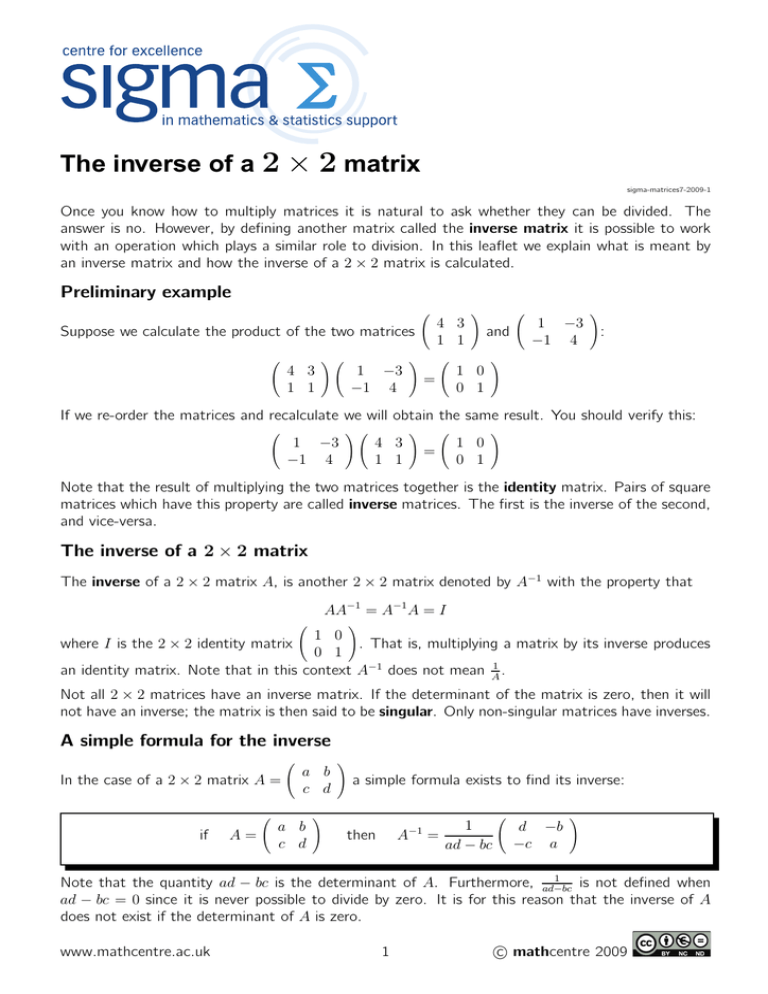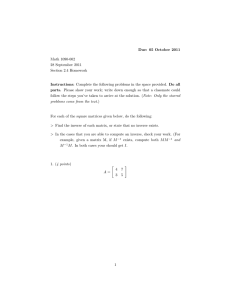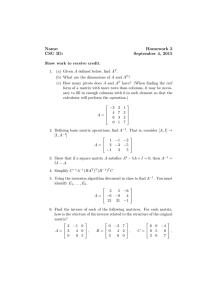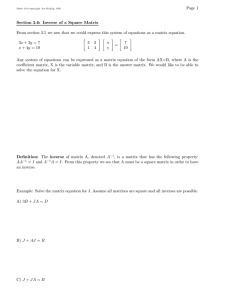2 × 2 The inverse of a matrix
advertisement

The inverse of a 2 × 2 matrix sigma-matrices7-2009-1 Once you know how to multiply matrices it is natural to ask whether they can be divided. The answer is no. However, by defining another matrix called the inverse matrix it is possible to work with an operation which plays a similar role to division. In this leaflet we explain what is meant by an inverse matrix and how the inverse of a 2 × 2 matrix is calculated. Preliminary example 4 3 1 1 Suppose we calculate the product of the two matrices 4 3 1 1 ! ! 1 −3 −1 4 = ! 1 0 0 1 and 1 −3 −1 4 ! : ! If we re-order the matrices and recalculate we will obtain the same result. You should verify this: 1 −3 −1 4 ! ! 4 3 1 1 = 1 0 0 1 ! Note that the result of multiplying the two matrices together is the identity matrix. Pairs of square matrices which have this property are called inverse matrices. The first is the inverse of the second, and vice-versa. The inverse of a 2 × 2 matrix The inverse of a 2 × 2 matrix A, is another 2 × 2 matrix denoted by A−1 with the property that AA−1 = A−1 A = I ! 1 0 where I is the 2 × 2 identity matrix . That is, multiplying a matrix by its inverse produces 0 1 an identity matrix. Note that in this context A−1 does not mean A1 . Not all 2 × 2 matrices have an inverse matrix. If the determinant of the matrix is zero, then it will not have an inverse; the matrix is then said to be singular. Only non-singular matrices have inverses. A simple formula for the inverse In the case of a 2 × 2 matrix A = if A= a b c d a b c d ! ! a simple formula exists to find its inverse: A then −1 1 = ad − bc d −b −c a ! 1 Note that the quantity ad − bc is the determinant of A. Furthermore, ad−bc is not defined when ad − bc = 0 since it is never possible to divide by zero. It is for this reason that the inverse of A does not exist if the determinant of A is zero. www.mathcentre.ac.uk 1 c mathcentre 2009 Example ! 3 1 4 2 Find the inverse of the matrix A = . Solution Using the formula A −1 1 = (3)(2) − (1)(4) 1 = 2 This could be written as 2 −1 −4 3 1 − 12 −2 32 2 −1 −4 3 ! ! ! You should check that this answer is correct by! performing the matrix multiplication AA−1 . The 1 0 result should be the identity matrix I = . 0 1 Example 2 4 −3 1 Find the inverse of the matrix A = ! . Solution Using the formula A −1 1 = (2)(1) − (4)(−3) 1 = 14 This can be written 1/14 −4/14 3/14 2/14 ! although it is quite permissible to leave the factor 1 14 A −1 = 1 −4 3 2 1 −4 3 2 ! 1/14 −2/7 3/14 1/7 = ! ! at the front of the matrix. Example Find, if possible, the inverse of the matrix A = 3 2 6 4 ! . Solution In this case the determinant of the matrix is zero: 3 2 = 3×4−2×6=0 6 4 Because the determinant is zero the matrix is singular and no inverse exists. We explain how to find the inverse of a 3 × 3 matrix in a later leaflet in this series. Note that a video tutorial covering the content of this leaflet is available from sigma. www.mathcentre.ac.uk 2 c mathcentre 2009







